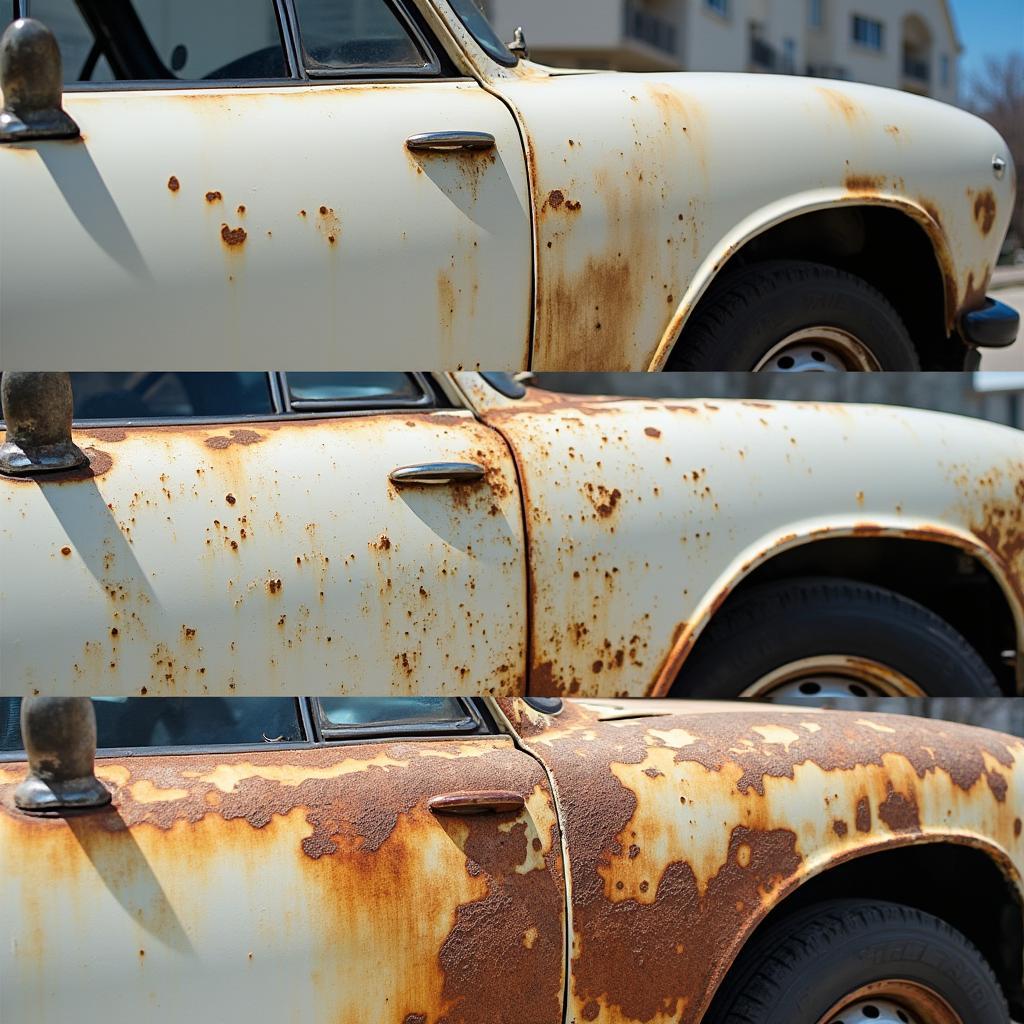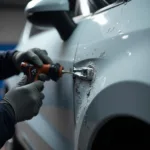Dealing with rust on your car is a frustrating but unavoidable reality for many car owners. Ignoring the problem will only worsen it, potentially leading to costly repairs down the line. Fortunately, tackling car body rust repair doesn’t always require a trip to the auto shop. With the right tools and a bit of know-how, you can effectively address minor to moderate rust issues yourself. This guide will equip you with the knowledge and resources to confidently choose the best car body rust repair tools for your needs.
Understanding Your Rusty Enemy: Types of Car Rust
Before diving into the world of rust repair tools, it’s crucial to understand the nature of your rusty foe. Different types of rust require different approaches and tools for effective treatment.
- Surface Rust: This is the initial stage, appearing as reddish-brown discoloration on your car’s paint. While primarily a cosmetic issue, it can worsen if left unaddressed.
- Scale Rust: As surface rust progresses, it eats into the metal, creating a flaky, scaly texture. This stage requires more than just cosmetic fixes.
- Penetrating Rust: This is the most severe form, where rust has eaten through the metal, potentially compromising its structural integrity. Repairing penetrating rust often necessitates professional intervention.
Essential Tools for Effective Car Body Rust Repair
Tackling car body rust effectively requires the right tools. Here are some must-haves for your DIY arsenal:
1. Safety First: Protective Gear
Before you begin, prioritize safety! Equip yourself with:
- Gloves: Protect your hands from sharp metal edges and harsh chemicals.
- Safety Glasses: Shield your eyes from flying debris during sanding and grinding.
- Respirator Mask: Essential when sanding, grinding, or using rust converters, as these processes create fine particles harmful if inhaled.
2. Surface Preparation: The Foundation of a Lasting Fix
Proper surface preparation is paramount for successful rust repair. These tools will help you achieve a clean, prepped surface for optimal results:
- Sandpaper (various grits): Start with coarser grits (80-120) to remove loose rust and paint. Gradually progress to finer grits (220-400) for a smooth finish.
- Wire Brush/Wheel: Useful for removing rust from tight spaces and intricate areas where sandpaper can’t reach.
- Rust Dissolver/Remover: These chemical solutions effectively break down rust, making it easier to remove. Always follow product instructions carefully.
- Masking Tape and Paper: Protect surrounding areas from paint, primer, and rust converter overspray.
3. Rust Conversion: Transforming the Enemy
Rust converters are a DIYer’s best friend. These chemical agents react with rust, converting it into a stable, paintable surface:
- Rust Converter Primer: These primers contain rust-converting properties, providing a convenient two-in-one solution.
- Dedicated Rust Converter: For more stubborn rust, opt for a dedicated converter before priming and painting.
4. Filling and Shaping: Recreating the Surface
Once the rust is neutralized, you might need to fill in any pits or holes to restore a smooth surface:
- Body Filler: A two-part putty that hardens quickly, ideal for filling small to medium-sized imperfections.
- Fiberglass Filler: Stronger than body filler, suitable for larger holes or areas requiring structural reinforcement.
- Putty Knife/Spreader: Essential for applying and smoothing out body filler or fiberglass filler.
5. Smoothing and Finishing: The Final Touches
Achieving a professional-looking repair requires meticulous smoothing and finishing:
- Sanding Blocks: Ensure even pressure when sanding down filler and primer for a level surface.
- Primer: Creates a uniform base for paint adhesion and helps to prevent future rust.
- Paint: Choose a paint that matches your car’s existing finish for a seamless repair.
Car Body Rust Repair: Frequently Asked Questions
Here are answers to some common questions about car body rust repair:
- Can I use household vinegar to remove rust? While vinegar can temporarily remove light surface rust, it’s not a lasting solution. For effective rust repair, utilize dedicated rust removal products and methods.
- How long will a DIY rust repair last? The longevity of a DIY repair depends on the severity of the initial rust, the quality of the tools and materials used, and the thoroughness of the preparation and application processes. A well-executed DIY repair can last several years.
- Is it worth repairing rust on an old car? This depends on the car’s overall condition and the extent of the rust. If the rust is widespread and the car requires significant additional repairs, it might not be cost-effective. However, if the car is in good condition otherwise and the rust is localized, repair can be a worthwhile investment.
Need Expert Assistance? We’re Here to Help!
For expert guidance and support on your car body repair journey, connect with us via WhatsApp: +1(641)206-8880 or email us at: [email protected]. Our dedicated team is available 24/7 to address your queries and provide top-notch assistance.
Remember, addressing rust promptly is key to preserving your car’s value and ensuring a smooth, safe ride for years to come. By arming yourself with the right knowledge and tools, you can conquer car rust head-on and keep your vehicle looking its best.



